Australia
Playing cards from Australia.

Above: Australian ace of spades designed to mimic a national coat of arms, W. Thomas & Co., c.1910
Playing cards from Australia
At first cards were exported to Australia from England and newspaper adverts for cards being imported exist from as early as 1803. Belgian manufacturers also exported cards to Australia during the 19th century and American cards influenced the local cardmakers. But there is not a long history of local manufacturing and there has probably never been a company in Australia whose sole business was making playing cards. The advent of television and more recently computers and the Internet have diminished the popularity of playing cards as a leisure pastime and as a manufacturing proposition. Most cards today arrive in ships from Shanghai.
The earliest known manufacturer was C. Troedel and Co. who were printing cards in the mid-1880s. Before the 1920s it seems that most Australian cards were made by small local enterprises producing small editions. It was not uncommon, especially in more remote parts of the country, for local newspapers to be involved in the production of playing cards because they had the resources. Usually these cards showed local scenes on the back or advertised local companies. In 1922 the Australasian Publication Company were given the sole rights for a three year period to sell Waddington’s playing cards in Australia and New Zealand, and in 1930 Waddington’s unsuccessfully tried to establish a manufacturing branch in Sydney. It is also recorded that there had been a dispute with Chas Goodall & Co regarding the use of the word ‘linen’ in connection with playing cards which was settled amicably. The brand name ‘Silkette’ was also used by Waddington in the 1920s & 30s.
The heyday of Australian playing card manufacture is roughly between 1930-1970, with several companies reaching their peaks during the 1940s and 50s. Alongside the more prestigious brands, most manufacturers also produced ‘budget’ decks in the 1930s to WWII era - possibly due to the early 1930s depression and then paper restrictions during/just after the war. Tax was levied on cards in Australia from 1932. From then onward all Australian manufacturers were required to have their code number printed on each pack, as well as ‘Made In Australia’. read more→
Perhaps the most productive company was Paper Products Pty Ltd of Sydney which commenced in 1929. Brand names include Pompadour, Silkette, Silver Cat, Silver Belt, Golden Eagle, Top Hat, Two Hundred, Royal Charter, Queen’s Slipper, Cambric, Chevalier and Canberra. However, by the late 1970s all the local manufacturing companies seem to have disappeared, or manufacturing was outsourced to Singapore or China.
Non-Standard
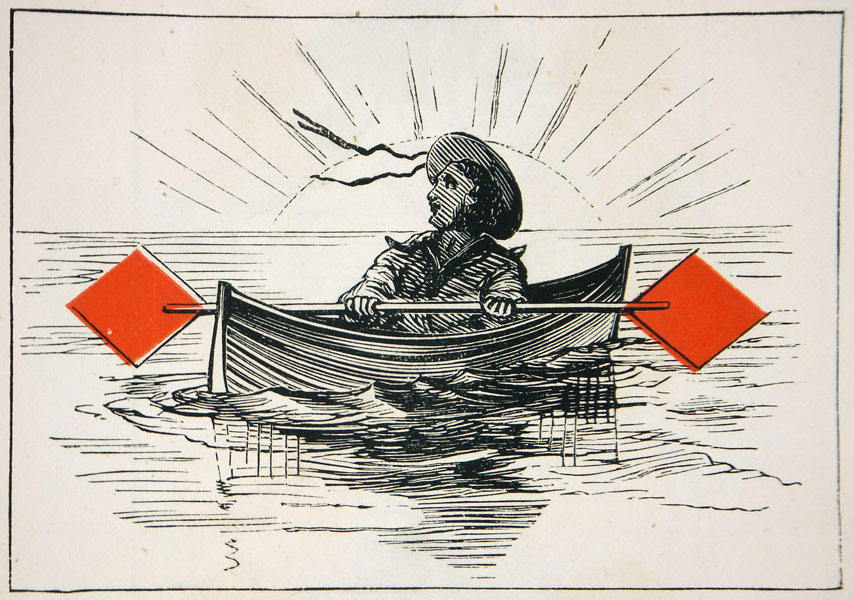
Above: “A Motley Pack” published in Melbourne in 1875.
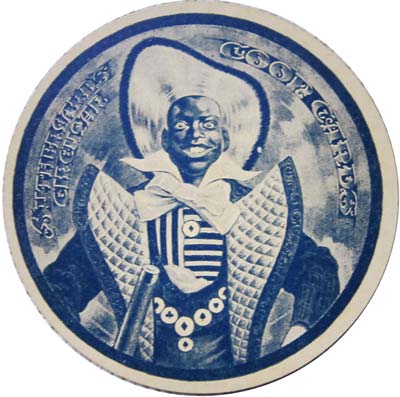
Above: Sutherland’s “Circular Coon Cards”, published in Melbourne but possibly of American manufacture, late 19th century
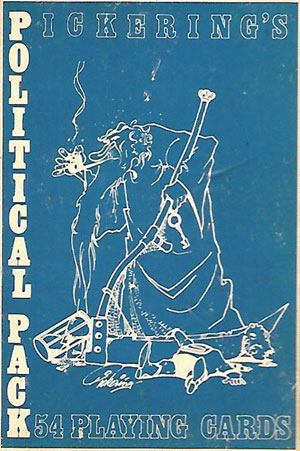
Above: Pickering’s Political Pack depicting caricatures of famous Australian politicians, Jerningham Press, 1975
Souvenir

Above: “Picturesque Australia Souvenir” printed by W. Thomas (Detmold), c.1908
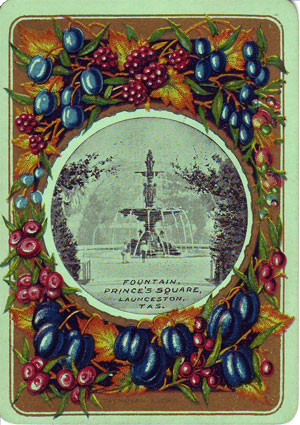
Above: back of 1906 edition of “Tasmanian Souvenir” pack. The cards were printed in the offices of ‘The Examiner’ newspaper.
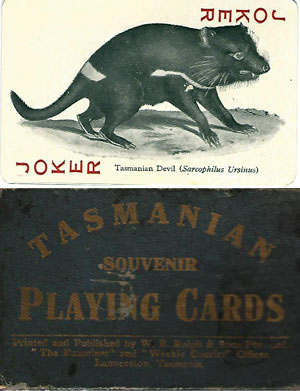
Above: “Tasmanian Souvenir” pack, published by W.R. Ralph and Sons, founder of several local newspapers, with photographic scenes of Tasmania. A wider sized version was first published 1906.

Above: “56 Australian Views” souvenir playing cards, Valentines (Hudson), is dated mid 1940s around the end of WW2, and is often on poor quality paper, as with most paper items around that time.
Designer
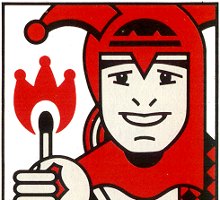
Above: “Redheads Match Poker“ playing cards published by the Australian match producer Bryant & May, c.1975-80

Above: Lonely Planet playing cards, 2002

Above: Enchanted Journey playing-cards by Karen Curran, 2003
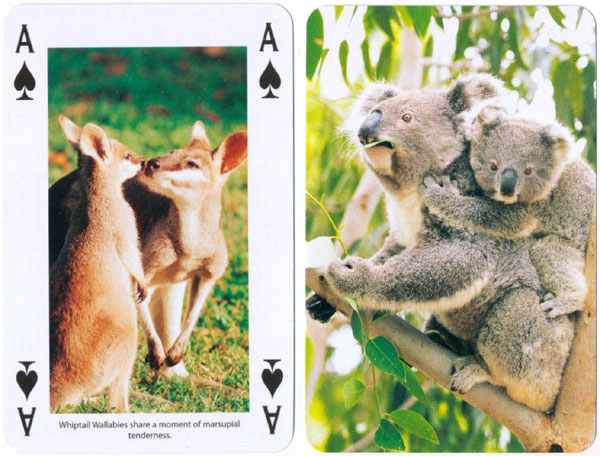
Above: Australia souvenir by Steve Parish
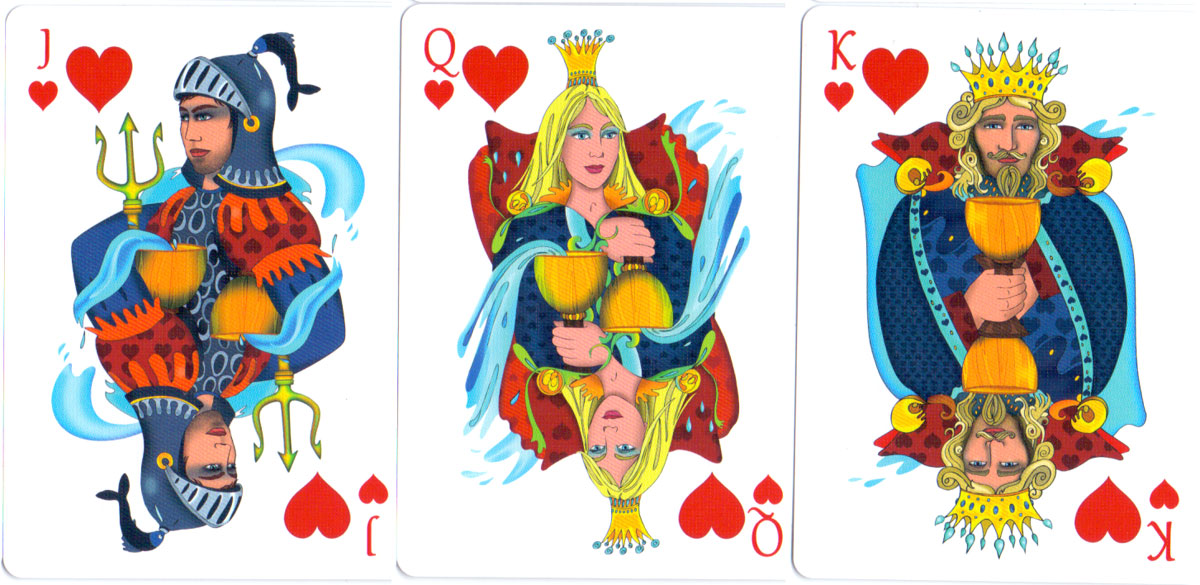
Above: “Nine Lives“ playing cards by Annette Abolins, 2016
Card Games
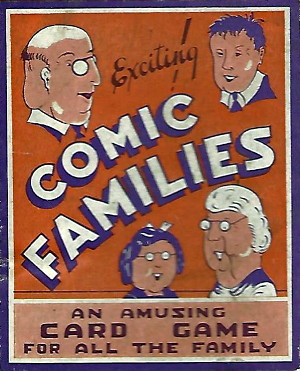
Above: “Comic Families” children’s card game, Paper Products, 1940s

Above: Aussie version of the UK game of Pit, Paper Products, 1940s

Above: “Drover’s Dilemma” card game, 1984
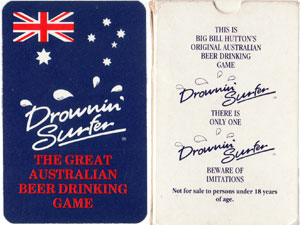
Above: “Drownin’ Surfer” beer drinking card game
Fortune Telling

Above: “Old Witch” fortune-telling cards made by Paper Products Pty Ltd, 1950s.
See also: “Zingara Gipsy Fortune-Telling” playing cards, c.1910
Tarot
Above: “Watersprite Tarot“ created by Alison McDonald, 2012

Above: “Nine Lives Tarot“ created by Annette Abolins, 2013
Conjuring
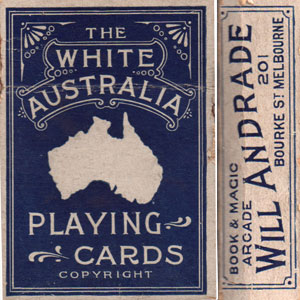
Above: Will Andrade’s “White Australia” pack, c.1925, made up of 32 cards plus 18 duplicates + one 2C, presumably for magic tricks.

Above: Stuthard’s “Stripmark” Magic playing cards, Hudson Industries Pty Ltd c.1950 or 1960. There is also a Stuthard Svengali deck.
More
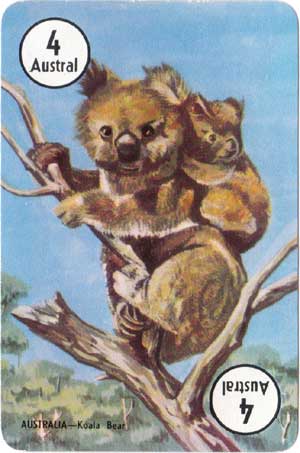
Above: Australian themed card from Round the World card game published in 1961.
Standard Playing Cards & Manufacturers
Towards the end of the 19th century playing cards were the most popular sedentary leisure pursuit in Australia after reading. There was no TV, radio or Scrabble. Large numbers of packs of standard playing cards were imported each year, chiefly from UK. Belgian manufacturers also exported their wares to Australia during the 19th century.
Standard playing cards made in Australia tend to have court cards based upon American designs, even using American registered brands such as ‘Squeezers’. Very often the early packs and boxes are anonymous, hard to identify (maybe to avoid paying taxes), with the only clue being the courts and/or joker.
William Detmold Ltd
W. Thomas & Co., Melbourne 1890s-1922
William Detmold Ltd manufactured playing cards trading as W. Thomas & Co, and at some point around 1922 became Spicer & Detmold read more →

Above: W. Thomas & Co Ace of Spades, c.1900
Spicer & Detmold
Spicer-Detmold commenced around 1922 but in 1948 became known as Spicers (Australia) until Reed took it over in c.1960 with the Melbourne factory closing down and all cards printed in Sydney. “Koala”, “Coronet”, “St George”, “Tudor” and “Tudor Rose” were popular brands see more→

Above: Spicer & Detmold, c.1935 see more→
Robert G. Nall Ltd
A company named Fuerth and Nall is believed to have commenced in the 1880s. Robert G Nall was in partnership with Leopold Fuerth but the partnership was dissolved in 1882, with Robert G Nall maintaining the name and business of Fuerth and Nall (Ltd added after 1905). In c.1920 the name changed to Robert G. Nall Ltd and was changed yet again in c.1928 to Paper Products Ltd. This then became known as Reed Paper Products.
Reed Paper Products
Reed Paper Products of Waterloo manufactured playing cards until the late 1970s. Paper Products became Reed Paper Products in 1961, then Reed Consolitated Industries in 1966. Around 1978 Reed sold the playing cards off to Hardie Industries, and that part of the business became known as James Hardie Spicers, and a new factory was opened in Melbourne around 1979/80.
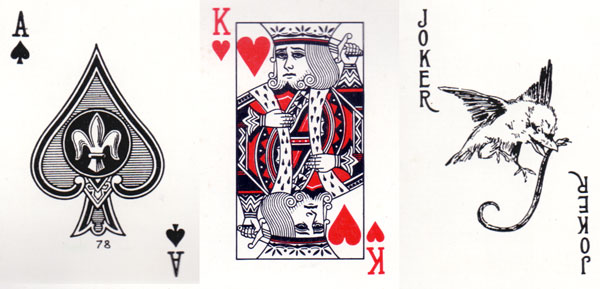
Above: Reed Paper Products

Above: XII Commonwealth Games, Brisbane 1982, printed by Spicers. Note the Piatnik courts.
James Hardie Spicers
James Hardie Spicers printed advertising and casino playing cards under the Queen’s Slipper name. James Hardie sold to Spicers Paper in 1988.
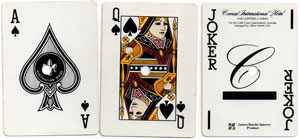
Above: James Hardie Spicers for Conrad International Hotel and Jupiter Casino
Spicers Paper Ltd
James Hardie sold off the playing cards in 1988, and it was then known as Spicers Paper Limited. Paperlinx was a parent company which spun off the Spicers Paper assets in 2001. Paperlinx sold off various brands - including the Queen’s Slipper cards - to Nippon Paper Industries in 2009.
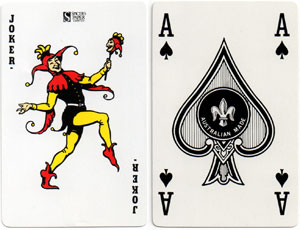
Above: Spicers Paper Ltd 1988-90
Queen’s Slipper
The design application was first registered in 1923 along with the Silkette brand, although the brands were being advertised even earlier. Today Queen’s Slipper cards are part of the Australian Paper group, and this is owned by Nippon Paper Industries. Still being printed at the Raglan St. Preston factory in Melbourne. They purchased the brands from Paperlinx in 2009. See: Queen’s Slipper→
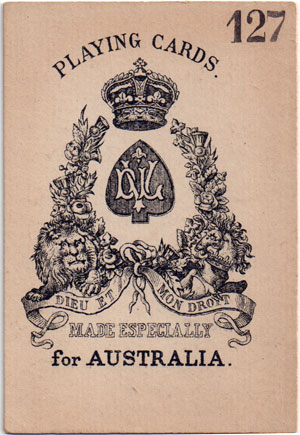
Above: sample card with rip-off of Bancks’ ace of spades by Van Genechten (Belgium) masquerading as British manufacture, c.1880
Sands & McDougall, Melbourne, late 1890s-c.1970
Sands & McDougall had brands registered in the late 1890s. Brand names include “Silhouette”, “Invicta”, “Jewel” and a selection of cheaper, budget decks such as “Emu”, “Tiger” and “Kangaroo”. They also produced a number of very attractive aces and jokers for advertising see more →
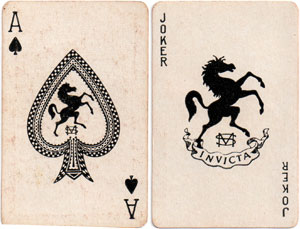
Above: Sands & McDougall see more →

Above: ‘Pelaco’ playing cards with Aboriginal characters by Sands & McDougall, c.1930
Hudson Industries Pty Ltd
Hudson Industries Pty Ltd of Rathdown Street, Carlton in Victoria first registered as a printing company in 1920. Hudsons sold out to Valentines in 1972 see more→

The Valentine Group
The Valentine Publishing Company of Clayton, Victoria was first registered as Valentine & Sons in 1919. They sold out to John Sands in 1989 see more→
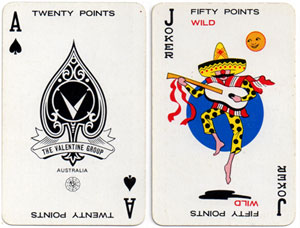
Above: Valentine Group “Canasta”
John Sands
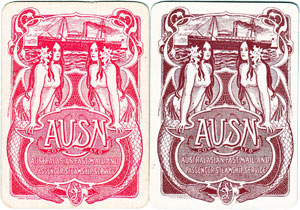
Above: John Sands for AUSN, c.1920
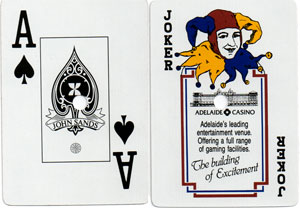
Above: John Sands for Adelaide Casino, 1992 see more→
SNP Ausprint Pty Ltd
Formerly part of Singapore National Printers (SNP). Brands include Ausgold, Unicorn and numerous decks for casinos. Closed down in 2008.
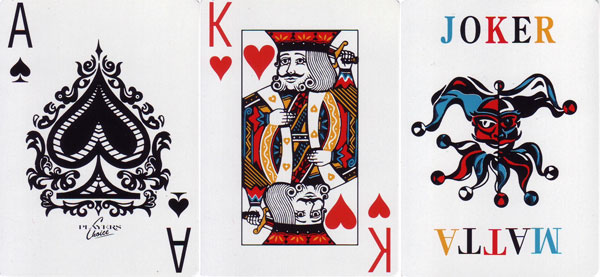
Above: SNP Ausprint Pty Ltd see more→
REFERENCES & CREDITS
Lodge, Ken: The Standard English Pattern (second revised and enlarged edition), Bungay, Suffolk, 2010. See Ken Lodge’s Blog→
Thomas, Nicholas: Collecting Australian playing cards in “Antiques and Collectables for Pleasure & Profit”, Coffs Harbour NSW, issue 28, August/September 2008
Watson, Victor: The Waddingtons Story, Northern Heritage Publications, 2008
Thanks to Nick Thomas, Jan Walls [APCCS], John Daniels, Ray Nilsson, Ken Lodge, Barney Townshend, Rex Pitts and Mike Goodall for kindly contributing information and images of decks from their collections.

Related Articles

Pride playing cards
Pride playing cards designed by Phil Constantinesco

The Millenium Tarot: Tarot of the Four Worlds
First Australian Tarot, designed by Mary Susan Chamberlain, with artwork by Ziba Vilmanis-Westenberg...

Scenic Views of Australia
54 different scenic views of Australia in full colour.

Pack of Thieves?
“Pack of Thieves? 52 Port Arthur Lives” playing cards documenting life in an Australian penal settle...

Unique Australian Animals
‘Unique Australian Animals’ educational playing cards designed by Lawton Ho, Australia, 2004.

Cyberpunk Playing Cards by Elephant
Cyberpunk playing cards, combining themes of lowlife and high tech. Created by Ben Jones, produced b...

Wimmera Playing Cards
Different scenes from the Wimmera region of Victoria, Australia, drawn by Colin Daniels.

Transformation Cards for Christmas
Hand-drawn Transformation cards, c.1870.

Bosch Puzzle Playing Cards
Bosch Puzzle Playing Cards by Sunish Chabba, 2020.

Qantas
Qantas Airways Limited is the flag carrier of Australia and is the world's third-oldest airline stil...

Collecting Playing Cards with Jan Walls
I collected playing cards when I was in primary school, by Jan Walls.

On The Cards
A Motley Pack - transformation playing cards & ‘On The Cards’ book facsimile published by Sunish Cha...

Billabong playing cards
Billabong Dual Deck by Hudson Industries, 1950s.

Kalevala
Kalevala playing cards by Sunish Chabba and Ishan Trivedi inspired by ancient Finnish mythology.

Adelaide Casino
Adelaide Casino by Spicers Paper Ltd, 1987.

Erlenmeyer City Sights
Erlenmeyer City Sights hand-illustrated playing cards by Stephanie Gray, 2015.
Most Popular
Our top articles from the past 28 days

